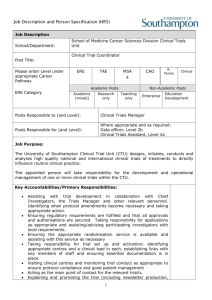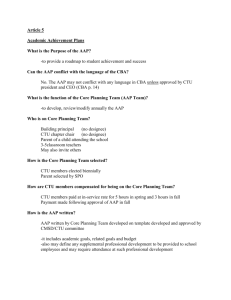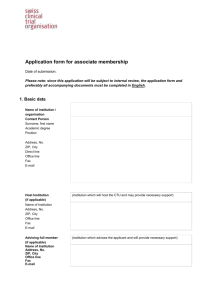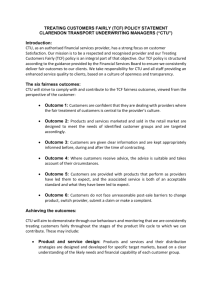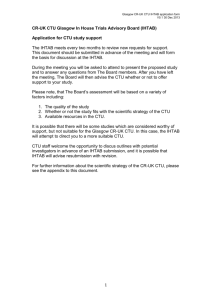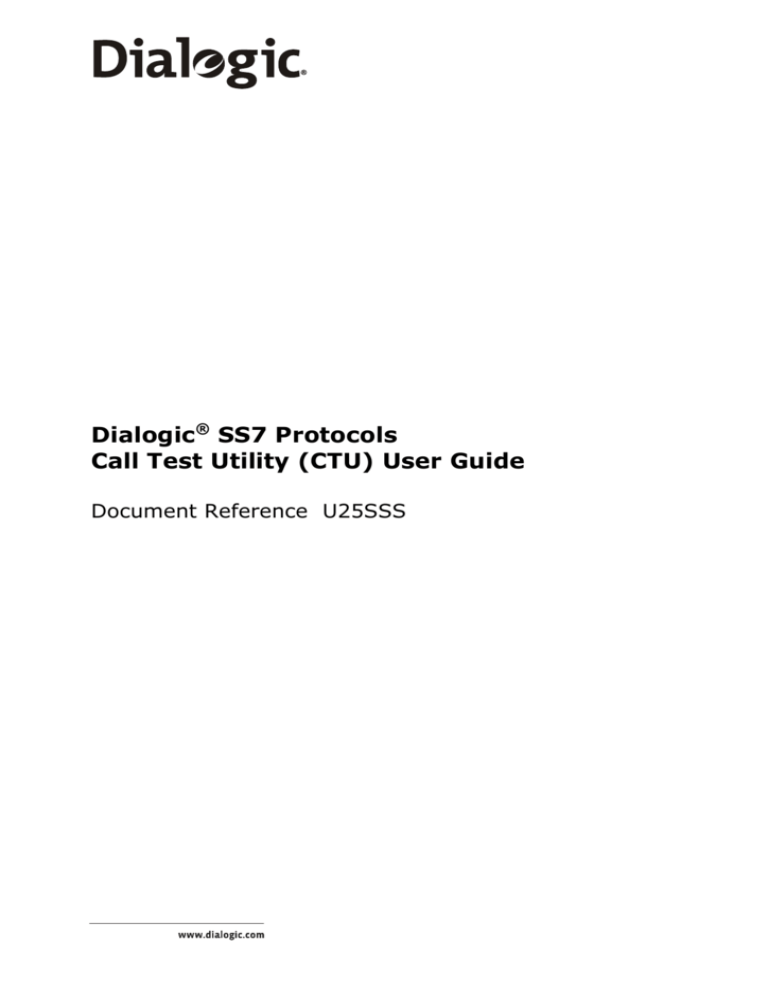
Dialogic® SS7 Protocols
Call Test Utility (CTU) User Guide
Document Reference U25SSS
Section 1 Introduction
Copyright © 2005-2007 Dialogic Corporation. All Rights Reserved. You may not reproduce this
document in whole or in part without permission in writing from Dialogic Corporation.
All contents of this document are furnished for informational use only and are subject to change without notice and do not represent a
commitment on the part of Dialogic Corporation. Reasonable effort is made to ensure the accuracy of the information contained in the
document. However, Dialogic Corporation does not warrant the accuracy of this information and cannot accept responsibility for errors,
inaccuracies or omissions that may be contained in this document.
INFORMATION IN THIS DOCUMENT IS PROVIDED IN CONNECTION WITH DIALOGIC® PRODUCTS. NO LICENSE, EXPRESS
OR IMPLIED, BY ESTOPPEL OR OTHERWISE, TO ANY INTELLECTUAL PROPERTY RIGHTS IS GRANTED BY THIS
DOCUMENT. EXCEPT AS PROVIDED IN A SIGNED AGREEMENT BETWEEN YOU AND DIALOGIC, DIALOGIC ASSUMES NO
LIABILITY WHATSOEVER, AND DIALOGIC DISCLAIMS ANY EXPRESS OR IMPLIED WARRANTY, RELATING TO SALE
AND/OR USE OF DIALOGIC PRODUCTS INCLUDING LIABILITY OR WARRANTIES RELATING TO FITNESS FOR A
PARTICULAR PURPOSE, MERCHANTABILITY, OR INFRINGEMENT OF ANY INTELLECTUAL PROPERTY RIGHT OF A THIRD
PARTY.
Dialogic products are not intended for use in medical, life saving, life sustaining, critical control or safety systems, or in nuclear facility
applications.
It is possible that the use or implementation of any one of the concepts, applications, or ideas described in this document, in marketing
collateral produced by or on web pages maintained by Dialogic Corporation or its subsidiaries may infringe one or more patents or other
intellectual property rights owned by third parties. Dialogic Corporation does not provide any intellectual property licenses with the sale of
Dialogic products other than a license to use such product in accordance with intellectual property owned or validly licensed by Dialogic
Corporation or its subsidiaries and no such licenses are provided except pursuant to a signed agreement with Dialogic Corporation. More
detailed information about such intellectual property is available from Dialogic Corporation’s legal department at 9800 Cavendish Blvd.,
Montreal, Quebec, Canada H4M 2V9. Dialogic Corporation encourages all users of its products to procure all necessary intellectual property
licenses required to implement any concepts or applications and does not condone or encourage any intellectual property infringement and
disclaims any responsibility related thereto. These intellectual property licenses may differ from country to country and it is the responsibility
of those who develop the concepts or applications to be aware of and comply with different national license requirements.
Dialogic is a registered trademark of Dialogic Corporation. Dialogic's trademarks may be used publicly only with permission from Dialogic.
Such permission may only be granted by Dialogic’s legal department at 9800 Cavendish Blvd., 5th Floor, Montreal, Quebec, Canada H4M
2V9. Any authorized use of Dialogic's trademarks will be subject to full respect of the trademark guidelines published by Dialogic from time
to time and any use of Dialogic’s trademarks requires proper acknowledgement.
Windows and Visual C++ are registered trademarks of Microsoft Corporation in the United States and/or other countries. Other names of
actual companies and products mentioned herein are the trademarks of their respective owners.
Publication Date: October 2007
Document Number: U25SSS, Issue 3
2
Call Test Utility (CTU) User Guide Issue 3
Revision History
ISSUE
DATE
CHANGES
1
05-Oct-01
Initial release
2
16-Jun-03
Branding changed: Septel PCI now SPCI4/SPCI2S and
SPCI2S, SPCI4S and CPM8 now CPM8. References to NUP,
QNX and SCO removed.
3
01-Oct-07
Remove references to PCCS6 and add support for SIGTRAN
M2PA links
3
Section 1 Introduction
Contents
1
1.1
2
Introduction ................................................................................................................................. 5
Software requirements................................................................................................................. 5
CTU Application .......................................................................................................................... 6
2.1
Message Sequence Chart ........................................................................................................... 7
2.2
Customizing the CTU application ................................................................................................ 9
2.3
CTU source code ....................................................................................................................... 10
3
Building the CTU application ................................................................................................... 11
3.1
Host software directory structure ............................................................................................... 12
3.2
Building CTU.............................................................................................................................. 12
4
Configuration............................................................................................................................. 14
4.1
System Configuration ................................................................................................................ 14
4.1.1
4.1.2
4.1.3
4.2
SPCI2S, SPCI4 and SS7HD .................................................................................................... 14
SIGTRAN M2PA....................................................................................................................... 14
SS7G2x SIU ............................................................................................................................. 14
Protocol Configuration ............................................................................................................... 15
4.2.1
4.2.2
ISUP ......................................................................................................................................... 15
TUP........................................................................................................................................... 15
5
5.1
5.1.1
Running the CTU application................................................................................................... 16
CTU Command Line Arguments................................................................................................ 16
CTU Options ............................................................................................................................. 17
6
References ................................................................................................................................. 18
7
Abbreviations ............................................................................................................................ 19
4
Call Test Utility (CTU) User Guide Issue 3
1 Introduction
The Dialogic® Call Test Utility (CTU) is an example application designed to demonstrate the use of the
Dialogic® ISUP and TUP modules. This user guide describes the design, build and usage of this
application for developers.
The purpose of CTU is to demonstrate the behavior of the telephony modules by offering simple
functionality while showing real examples of the interface to the modules. The CTU application can
also be used to provide simple verification of system configuration and set-up.
This user guide is intended for users who choose to develop their own applications that will interface
with and use the functionality provided by the ISUP and TUP modules.
1.1
Software requirements
The CTU application requires the following software:
1.
Dialogic® SS7 Development Package
2.
Dialogic® User Part Development Package
3.
For TDM-based configurations:
•
ss7.dc3 or ss7.dc4 codefile
•
Dialogic® MTP3, ISUP/TUP host binaries, as required
4. For SIGTRAN-based configurations:
•
Dialogic® M2PA, MTP3, ISUP/TUP host binaries, as required
Software can be downloaded from
http://www.dialogic.com/support/helpweb/signaling/software3.htm
5
Section 2 CTU Application
2 CTU Application
The Dialogic® CTU application is used to receive incoming calls. When an incoming call is received,
CTU performs simple checks on the parameters in the received message for example checking the
parameter name and its length, and answers the call before making an outgoing call on the next
circuit.
ISUP (or TUP)
User
CTU
Exchange
Incoming call (circuit n)
(or test equipment)
Outgoing call (circuit n+1)
Figure 1. CTU Network Architecture
CTU takes a number of command line options (refer to Section 5.1 CTU Command Line Arguments),
which if set shall allow full tracing of sent and received messages.
CTU
script file and
s7_log
ISUP or TUP
ISUP or TUP
MTP2 or M2PA
MTP2 or M2PA
Point code 1
Point code 2
Figure 2. Typical configuration
6
Call Test Utility (CTU) User Guide Issue 3
2.1
Message Sequence Chart
The following pages contain message sequence charts showing typical message flows for phone calls
made when using CTU. Each chart shows the message flow between the application and the
telephony module e.g. ISUP.
As a basic behavior, CTU waits for a Setup Indication to be received and then responds with an
Alerting Request followed by a Setup Response on the same circuit. (Refer to the appropriate
programmer’s manual [1] and [2] for further information). After the incoming call is connected, CTU
initiates a new outgoing call on the next circuit (with a Setup Request using the same parameters as
those in the received Setup Indication) and waits for the remote application to complete the connection
(Figure 4).
Telephony module
CTU
Network
Idle
Setup Indication cct n
IAM
Alerting Request cct n
ACM
Setup Response cct n
ANM
IC
Active
Release Indication cct n
Wait
REL
Idle
Release Confirmation cct n
RLC
Idle
Figure 3. Typical basic incoming call
7
Section 2 CTU Application
Telephony module
CTU
Network
Idle
IAM
Setup Request cct n+1
OG
Setup
ACM
Alerting Indication cct n+1
OG
Alerting
ANM
Setup confirmation cct n+1
REL
Release Request cct n+1
Wait
RLC
Release confirmation cct n+1
Idle
Figure 4. Typical basic outgoing call
8
Call Test Utility (CTU) User Guide Issue 3
2.2
Customizing the CTU application
CTU is example program for development using the ISUP and TUP protocols and as such, a number
of simplifications and limitations have been implemented.
It is possible to use the CTU application for the development of protocols, such as ISUP, irrespective
of its variant e.g. ITU-T, ANSI.
The main simplification and limitation is that the outgoing call is always made on the next circuit. In a
real application, whenever an incoming call is received some kind of processing would be required to
determine information such as circuit selection and routing. However, as an example application, CTU
will always use the same data that was received from the incoming call to setup the outgoing call.
CTU provides support for a limited number of messages and parameters. Therefore, only mandatory
and few optional parameters are supported. CTU has no provision for handling segmented messages
nor the ability to handle proprietary messages and parameters.
For parameters received by CTU, only supported parameters will be passed transparently from the
incoming call to the outgoing call to the remote end. Unsupported or unrecognized parameters are
ignored and shall consequently be discarded. Similarly, on receipt of an unsupported or unrecognized
message, the message shall be ignored and discarded. The CTU example program may be further
extended by the user to meet additional requirements.
Refer to Appendix E - Supported Messages and Parameters for a list of all messages and parameters
supported.
Refer to Appendix F - Adding new messages and parameters for information on adding new
messages and parameters.
9
Section 2 CTU Application
2.3
CTU source code
The CTU program can be found in the Dialogic® User Part Development Package. The following table
describes the files required by the CTU application:
File
Notes
ctu_main.c
This file contains the main() function. This reads the command line
arguments and passes them to ctu_ent().
ctu.c
The function ctu_ent() contains the main control loop for the application. It
waits for a message to be received and calls CTU_cal_ind() to handle
each one. CTU_cal_ind() first recovers the parameters into a C structure
(CAL_msg_to_ind()), displays the message according to the command
line options which were set (CTU_display_ind()), and then handles the
data received according to the current call state.
call.c
Call control interface library functions. This file contains functions for
recovering message parameters into a structured form
(CAL_msg_to_ind()), and vice versa (CAL_req_to_msg()).
call.h
Contains #defines, structure definitions and function prototypes used by
CTU. Includes "ccp_inc.h" (see Note).
snd_cgsc.c
This file is not part of the CTU example program but has been included to
demonstrate how blocking and reset may be initiated by using a Circuit
Group Supervision Control request.
Note: ccp_inc.h (included in the Dialogic® SS7 Development Package) contains #defines used by the
Common Call Control interface. Although these definitions are largely based on ITU-T Q.763, due to
the number of protocols and variants supported there may be some differences in the definitions used
as it is not always possible to use the same definition as specified by the ITU-T recommendation.
10
Call Test Utility (CTU) User Guide Issue 3
3 Building the CTU application
Example make-files for the following operating systems are provided and identified by a unique suffix:
Operating system
Suffix
Generic UNIX (Solaris, Linux)
.mak
Windows®
.mnt
A single definitions file (one for each operating system) which contains the definitions relating to the
user’s own development environment is supplied in the Dialogic® User Part Development Package.
The definitions files are as follows, and the appropriate file should be used depending on the operating
system:
makdefs.mak
(Linux)
makdefs_sol.mak
(Solaris)
makdefs.mnt
(Windows®)
For the Windows® operating system, a dynamically linked GCT library that allows the application to
link to the GCT functions is supplied in the Dialogic® SS7 Development Package as follows:
(Visual C++® compiler)
gctlib.dll
For ‘UNIX’, a GCT shared object is supplied in the Dialogic® SS7 Development Package
e.g.
libgctlib.so.1.0.0
(Linux & Solaris)
The source code for the example program should be compiled and linked with the appropriate library
for the operating system in use.
11
Section 3 Building the CTU application
3.1
Host software directory structure
To build the CTU application, the user should first ensure that the required files are copied into the
correct directories as follows:
1. Copy either the zip or tar file from the Dialogic® User Part Development Package to the Dialogic®
SS7 Development Package directory and decompress using the appropriate tool. The choice of
the zip or tar file is up to the user; both will create the UPD directory structure shown in the table
below. The table below shows files required by the CTU program only.
2. The C header files in the INC directory shown in the table below The C header files in the INC
directory shown in the table below list the header files required by the CTU program.
The following table lists the directory structure and files required to build the CTU programs
supplied on the Dialogic® User Part Development Package.
Root directory
Septel
3.2
INC
UPD
ccp_inc.h
msg.h
pack.h
ss7_inc.h
strtonum.h
sysgct.h
system.h
BIN
SRC
BACKUP_WIN
CTU
BACKUP_LNX
ctu.bnt
ctu.mnt
ctu.mak
ctu.c
ctu_iss.txt
ctu_main.c
call.c
call.h
BACKUP_SOL
makdefs.mnt
makdefs_sol.mak
makdefs.mak
makeall.bat
makeall
makeall_sol
Building CTU
It is assumed that the UPD is extracted in the Dialogic® SS7 Development Package directory i.e. for
Windows® C:\Septel as shown above.
A script is provided in the SRC directory to build and copy all of the example programs into the
UPD\BIN directory. To run this script, change to the SRC directory and type one of the following
commands depending on the operating system:
makeall.bat
(Windows®)
makeall
(Linux)
makeall_sol
(Solaris)
A pre-built copy of the CTU application, for each operating system, can be located within the backup
subdirectories in the BIN directory.
12
Call Test Utility (CTU) User Guide Issue 3
To build the CTU program, change to the SRC\CTU directory and type one of the following commands
depending on the operating system:
nmake /f ctu.mnt
make –f ctu.mak
make -f ctu_sol.mak
13
Section 4 Configuration
4 Configuration
The local and remote ends of the system need to be configured before the Dialogic® CTU application
may be run. Example configuration files are provided on the Dialogic® User Part Development
Package diskette and after installation will be stored in the directories as shown in the following table:
Root directory
RUN
CTU
“CONFIG1”
Config.txt
System.txt
“CONFIG2”
Config.txt
System.txt
The configuration files in the CONFIG1 (for point code 1) and CONFIG2 (for point code 2) directories
should be copied to the appropriate node. Refer to Appendix A - Example CTU configuration files for
further information.
4.1
System Configuration
The GCT environment is configured using the Dialogic® gctload program and the system.txt file. The
basic board configuration along with the Dialogic® MTP, SCCP, TCAP and MAP modules is achieved
using the config.txt file.
4.1.1 SPCI2S, SPCI4 and SS7HD
The GCT environment is configured using the gctload program and the system.txt file. The basic
board configuration along with the MTP, ISUP or TUP modules are configured using the config.txt file.
Example configuration files for CTU are contained in the Appendix . When running CTU on a
Windows® host system using a SPCI4 with the MTP3 and ISUP modules running on the board, the
provided example configuration files may be used without any modification. Configuration details for
other board types are also provided for reference.
4.1.2 SIGTRAN M2PA
It is also possible to run the CTU applications from 2 hosts connected in back-to-back with SIGTRAN
M2PA links.
4.1.3 SS7G2x SIU
System and protocol information is configured using the SIU management module and commands in
the config.txt and system.txt files. Further information on this can be obtained from the SIU user
manual [4].
Note: These files are not contained in the User Part Development Package.
14
Call Test Utility (CTU) User Guide Issue 3
4.2
Protocol Configuration
All protocol modules are configured using commands in the config.txt file. The example configuration
files given in the appendices will perform the appropriate protocol configuration shown below. If the
user wishes to better understand or alter the configuration given, the following sections will be of
interest.
Before configuring the protocol modules, it is useful to determine the following information relative to
each network entity:
•
Local point code
•
Remote point code
•
Point code format
•
Signaling timeslot
4.2.1 ISUP
The local point code is contained in the main ISUP configuration command (refer to the programmer’s
manual [1] for details). In addition, configuration commands are required for each circuit group.
4.2.2 TUP
The local point code is contained in the main TUP configuration command (refer to the programmer’s
manual [2] fir details). In addition, configuration commands are required for each circuit group.
15
Section 5 Running the CTU application
5 Running the CTU application
Before running the Dialogic® CTU application, the GCT environment must first be initialized and the
signaling links brought into service. This is achieved by running the Dialogic® gctload program, and
activating the links using the Dialogic® mtpsl utility. Refer to manuals [4], or [5] for details as
appropriate.
In the example configuration, calls must be initiated at the remote end (config2) either by the use of
test equipment or script files may be used in conjunction with the Dialogic® s7_play utility. If using
these example configuration files, CTU must be run at the end using config1. Example script files are
provided in Appendix B - Example script files.
For further information on these commands, refer to the appropriate Programmer’s manual ([1] or [2]).
5.1
CTU Command Line Arguments
The module takes a number of command line arguments, which are summarized below:
Option
Default
Notes
-m
0x3d
CTU module Id
-c
0x23
CTU user part module (defaults to ISUP). If using TUP
ensure that this is set to 0x4a.
-o
0x0010
Run-time options (defaults to display received indications)
Add together required values for tracing options, if
required (see section 5.1.1 CTU Options).
Example:
ctu –c0x23 –o0x0017
The above example will set the internal CTU tracing for ISUP with OPT_TR_PARAM, OPT_TR_PRIM,
OPT_TR_CALL and OPT_TR_RX_IND run time options. These options are described in the following
subsection.
16
Call Test Utility (CTU) User Guide Issue 3
5.1.1 CTU Options
Tracing option
Value
Notes
OPT_TR_PARAM
0x0001
Display received message parameter
buffer
OPT_TR_PRIM
0x0002
Display primitive messages
OPT_TR_CALL
0x0004
Display call parameters
OPT_TR_TX_REQ
0x0008
Display transmit requests
OPT_TR_RX_IND
0x0010
Display received indications
OPT_ANSI
0x0100
Configures CTU to run in ANSI mode
17
Section 6 References
6 References
[1] U04SSS, Dialogic® ISUP Programmer’s Manual
[2] U09SSS, Dialogic® TUP Programmer’s Manual
[3] U10SSS, Dialogic® Software Environment Programmer’s Manual
[4] 05-2302, Dialogic® SS7G2x SIU Mode User Manual
[5] U03HSP, Dialogic® Programmer's Manual for SPCI2S, SPCI4S and CPM8
[6] 05-2063, Dialogic® SS7HD Programmer’s Manual
[7] ITU-T Recommendation Q.763, Signaling System No.7 – ISDN user part formats and codes
[8] U04STN, Dialogic® Programmer's Manual for Sigtran Host Software
Updates to the documentation are available on the Dialogic web site at
http://www.dialogic.com/support/helpweb/signaling/default.htm
18
Call Test Utility (CTU) User Guide Issue 3
7 Abbreviations
The following lists acronyms alphabetically used in this user guide.
CTU
Call Test Utility
DPC
Destination point code
GID
Group ID
IC
Incoming
ISUP
ISDN User part
MTP
Message transfer part
OG
Outgoing
OPC
Originating point code
SIU
Signaling Interface Unit
SLC
Signaling link code
SSF
Sub-service field
TUP
Telephony user part
UP
User Part
19
Appendix A - Example CTU configuration files
Appendix A - Example CTU configuration files
This section provides example configuration files (system.txt and config.txt) for use with the Dialogic®
CTU application on a Windows® host system for Dialogic® SPCI4 boards. The ISUP module is running
on the board and CTU is running as module ID 0x3d.
Before configuring the protocol modules it is useful to determine information such as the local point
code and remote point code relative to each network entity. For this example configuration, the local
point code is 1 and the remote point code is 2(see Fig. 5).
Example configuration
Operating system:
Windows®
Board type:
SPCI4
Local point code:
1 (CTU)
Remote point code:
2 (test equipment or script files)
CTU module ID:
0x3d
Modules running on the board:
ISUP/MTP3
Modules running on the host:
None
CTU
Point code 1
Figure 5. Example configuration
20
“Script file”
Point code 2
Call Test Utility (CTU) User Guide Issue 3
A.1 system.txt
This section provides one example system.txt file for an SPCI4 board running under Windows® using
the example configuration described earlier in this appendix.
The following example system.txt file is valid for point code 1 and point code 2. All comments are
denoted by ‘*’. For reference, the provided system.txt file also includes example configurations for
TUP, although all commands specific to the TUP protocol modules have been commented out.
A.1.1 system.txt for point code 1(CTU) and point code 2(remote end)
********************************************************************
* Example system.txt.
* Edit this file to reflect your configuration.
********************************************************************
*
* Essential modules running on host:
*
LOCAL 0x20
* ssds - Board interface task
LOCAL 0x00
* tim_nt - Timer task
*
* Optional modules running on the host:
*
LOCAL 0xcf
* s7_mgt - Management/config task
LOCAL 0x3d
* ctu - Example user part task
LOCAL 0xef
* s7_log - Logs status, trace and error messages
*
* Modules running on the board (all redirected via ssd):
*
REDIRECT
0x23 0x20 * ISUP module
* REDIRECT 0x4a 0x20 * TUP module
REDIRECT
0x22 0x20 * MTP3 module
REDIRECT
0x71 0x20 * MTP2 module
REDIRECT
0x10 0x20 * CT bus/Clocking control module
REDIRECT
0x8e 0x20 * On-board management module
*
* Redirection of status indications:
*
REDIRECT
0xdf 0xef * LIU/MTP2 status messages
*
* Now start-up all local tasks:
*
FORK_PROCESS
..\..\..\..\ssds.exe
FORK_PROCESS
..\..\..\..\tim_nt.exe
FORK_PROCESS
..\..\..\..\tick_nt.exe
FORK_PROCESS
..\..\..\..\s7_mgt.exe
FORK_PROCESS
..\..\..\..\s7_log.exe
*
21
Appendix A - Example CTU configuration files
A.1.2 Using different operating systems and configurations
The following subsections provide information regarding the system.txt file if using different operating
systems or board-based configurations.
A.1.2.1 Running CTU with SS7HD
If using SSHD boards, the following lines:
REDIRECT
FORK_PROCESS
0x71
0x20
SSDS.EXE -d
* MTP2 module
REDIRECT
REDIRECT
REDIRECT
REDIRECT
0x81
0x91
0xe1
0xf1
*
*
*
*
FORK_PROCESS
SSDH.EXE -d
should be replaced by:
0x20
0x20
0x20
0x20
MTP2
MTP2
MTP2
MTP2
module_id
module_id
module_id
module_id
for
for
for
for
SP0
SP1
SP2
SP3
Refer to [5] for further information.
A.1.2.2 Running CTU on the with SS7G2x
If using the SIU, additional commands required by the SIU will need to be included. Therefore, the
example system.txt provided in this appendix should not be used. Refer to [4] for further information.
A.1.2.3 Running protocols on the host
If using a host binary, so that the protocol module is run on the host instead of the board, start up the
appropriate host binary using the FORK_PROCESS command, a LOCAL declaration should be added to
show that the module is running locally on the host and the corresponding REDIRECT command
(which redirects messages for that module to the board) should be removed.
Refer to [4], [5] and [5] as appropriate.
A.1.2.4 Running CTU with other operating systems
If using operating systems other than Windows®, the names of some of the executable files used in
the FORK_PROCESS commands need to be changed.
Refer to [4], [5] and [5] as appropriate.
A.1.2.5 Running CTU with TUP
TUP has a different module ID, 0x4a, from ISUP (0x23) and if TUP is to be run, on the board or on the
host ensure that the TUP module ID is specified in the system.txt file..
Refer to manuals [2] and [5] for further information as appropriate.
A.1.2.6 Running CTU with SIGTRAN M2PA
Add the following to ‘Modules running on the host’:
LOCAL
0xc2
* MBM - Management task
LOCAL
0xd0
* SCTPD module
LOCAL
0xd1
* SCTP module
22
Call Test Utility (CTU) User Guide Issue 3
LOCAL
0xc1
* M2PA module
Make sure these modules are started using the FORK_PROCESS commands as follows::
FORK_PROCESS
..\..\..\..\sctpd.exe
FORK_PROCESS
..\..\..\..\sctp.exe
FORK_PROCESS
..\..\..\..\m2pa_nt.exe -t
FORK_PROCESS
..\..\..\..\mbm.exe -d
Refer to manuals [8] for further information as appropriate.
23
Appendix A - Example CTU configuration files
A.2 config.txt
This section provides two example config.txt files for a SPCI4 board running under Windows® using
the example configuration described earlier in this appendix showing the protocol modules can be
configured for use.
The following example config.txt files are for point code 1 and point code 2. All comments are denoted
by ‘*’. For reference, the provided config.txt file also includes example configurations for TUP,
therefore all messages specific to the TUP protocol modules have been commented out.
Using the two example config.txt files (one at each end of the link) will allow a call using ISUP or TUP
with 14-bit point codes to be demonstrated. If connecting to other equipment, all the various
parameters in the file need to be examined to determine if they are compatible with the configuration
at the other end of the link, for example:
•
point codes (OPC, DPC)
•
variant of ISUP or TUP (e.g. ANSI ISUP, China TUP)
•
signaling timeslot
The example files provided in this appendix should not be used for the SIU (refer to [4] for further
information).
24
Call Test Utility (CTU) User Guide Issue 3
A.2.1 config.txt for point code 1 (CTU)
***************************************************************************
* This file needs to be modified to suit individual circumstances.
* Refer to the relevant Programmer's Manuals for further details.
*
***************************************************************************
* For SPCI2S, SPCI4S and CPM8 / PCI boards:
* SEPTELCP_BOARD <board_id> <flags> <code_file> <run_mode>
SEPTELPCI_BOARD 0 0x0043 ss7.dc3 ISUP
*
*
* Configure individual E1/T1 interfaces:
* LIU_CONFIG <board_id> <liu_id> <liu_type> <line_code> <frame_format>
<crc_mode>
*LIU_CONFIG 0 0 5 1 1 1
*
*
* MTP Parameters:
* MTP_CONFIG <reserved> <reserved> <options>
MTP_CONFIG 0 0 0x0000
*
* Define linksets:
* MTP_LINKSET <linkset_id> <adjacent_spc> <num_links> <flags> <local_spc>
<ssf>
MTP_LINKSET 0 2 2 0x0000 1 0x08
*
* Define signaling links:
* MTP_LINK <link_id> <linkset_id> <link_ref> <slc> <board_id> <blink>
<stream> <timeslot> <flags>
* (Note: For PCCS6 boards the first LIU port is stream=16
* whilst for SPCI2S, SPCI4S and CPM8 / PCI boards the first LIU port is
stream=0)
MTP_LINK 0 0 0 0 0 0 16 16 0x0006
*
* Define a route for each remote signaling point:
* MTP_ROUTE <dpc> <linkset_id> <user_part_mask>
MTP_ROUTE 2 0 0x0020
*
*
* Define any user provided Layer 4 protocol:
* MTP_USER_PART <service_ind> <module_id>
*MTP_USER_PART 0x0a 0x2d
*
*
* Configure ISUP module:
* ISUP_CONFIG <reserved> <reserved> <reserved> <options> <num_grps>
<num_ccts>
ISUP_CONFIG 0 0 0 0x0435 4 64
*
* Configure ISUP circuit groups:
* ISUP_CFG_CCTGRP <gid> <dpc> <base_cic> <base_cid> <cic_mask> <options>
*
<user_inst> <user_id> <opc> <ssf> <variant>
<options2>
ISUP_CFG_CCTGRP 0 2 0x01 0x01 0x7fff7fff 0x001c 0 0x3d 1 0x8 0 0x00
*
* Configure TUP Parameters:
* TUP_CONFIG <reserved> <reserved> <reserved> <options> <num_grps>
<num_ccts>
*TUP_CONFIG 0 0 0 0x8141 4 64
*
* Define TUP circuit groups:
* TUP_CFG_CCTGRP <gid> <dpc> <base_cic> <base_cid> <cic_mask> <options>
*
<user_inst> <user_id> <opc> <ssf>
25
Appendix A - Example CTU configuration files
*TUP_CFG_CCTGRP
26
0
1
0x01
0x01
0x7fff7fff
0x0030 0 0x3d 2 0x08
Call Test Utility (CTU) User Guide Issue 3
A.2.2 config.txt for point code 2 (remote end)
***************************************************************************
* This file needs to be modified to suit individual circumstances.
* Refer to the relevant Programmer's Manuals for further details.
*
***************************************************************************
*
* Configure individual boards:
*
* For SPCI2S, SPCI4S and CPM8 / PCI boards:
* SEPTELCP_BOARD <board_id> <flags> <code_file> <run_mode>
SEPTELPCI_BOARD 0 0x0043 ss7.dc3 ISUP
*
*
* Configure individual E1/T1 interfaces:
* LIU_CONFIG <board_id> <liu_id> <liu_type> <line_code> <frame_format>
<crc_mode>
LIU_CONFIG 0 0 5 1 1 1
*
*
* MTP Parameters:
* MTP_CONFIG <reserved> <reserved> <options>
MTP_CONFIG 0 0 0x0000
*
* Define linksets:
* MTP_LINKSET <linkset_id> <adjacent_spc> <num_links> <flags> <local_spc>
<ssf>
MTP_LINKSET 0 1 2 0x0000 2 0x08
*
* Define signaling links:
* MTP_LINK <link_id> <linkset_id> <link_ref> <slc> <board_id> <blink>
<stream> <timeslot> <flags>
* (Note: For PCCS6 boards the first LIU port is stream=16
* whilst for SPCI2S, SPCI4S and CPM8 / PCI boards the first LIU port is
stream=0)
MTP_LINK 0 0 0 0 0 0 16 16 0x0006
*
* Define a route for each remote signaling point:
* MTP_ROUTE <dpc> <linkset_id> <user_part_mask>
MTP_ROUTE 1 0 0x0020
*
*
* Define any user provided Layer 4 protocol:
* MTP_USER_PART <service_ind> <module_id>
*MTP_USER_PART 0x0a 0x2d
*
*
* Configure ISUP module:
* ISUP_CONFIG <reserved> <reserved> <reserved> <options> <num_grps>
<num_ccts>
ISUP_CONFIG 0 0 0 0x0435 4 64
*
* Configure ISUP circuit groups:
* ISUP_CFG_CCTGRP <gid> <dpc> <base_cic> <base_cid> <cic_mask> <options>
*
<user_inst> <user_id> <opc> <ssf> <variant>
<options2>
ISUP_CFG_CCTGRP 0 1 0x01 0x01 0x7fff7fff 0x001c 0 0xef 2 0x8 0 0x00
*
*
* Configure TUP Parameters:
* TUP_CONFIG <reserved> <reserved> <reserved> <options> <num_grps>
<num_ccts>
*TUP_CONFIG 0 0 0 0x8141 4 64
27
Appendix A - Example CTU configuration files
*
* Define TUP circuit groups:
* TUP_CFG_CCTGRP <gid> <dpc> <base_cic> <base_cid> <cic_mask> <options>
*
<user_inst> <user_id> <opc> <ssf>
*TUP_CFG_CCTGRP 0 1 0x01 0x01 0x7fff7fff 0x0030 0 0xef 2 0x08
*
* Message tracing:
ISUP_TRACE 0xffffffff 0xffffffff 0xffffffff
*TUP_TRACE 0xffffffff 0xffffffff 0xffffffff
28
Call Test Utility (CTU) User Guide Issue 3
A.2.3 Using different operating systems and configurations
The following subsections provide information regarding the config.txt file if using different operating
systems or board based configurations.
A.2.3.1 Running CTU with SS7HDP
If using SS7HDP boards, the SEPTELPCI_BOARD command should be replaced with the following:
SS7_BOARD
0 SS7HDP 0x0003
ss7.dc4
MTP2
Refer to [5] for further information.
A.2.3.2 Running CTU with host binary
When using a host binary so that the ISUP or TUP module is run on the host instead of the board:
•
For SPCI2S, SPCI4S and CPM8:
the <run_mode> field in the SEPTELCP_BOARD command should be set to an appropriate
‘runmode’ e.g. MTP2
Refer to [2] and [5] as appropriate.
A.2.3.3 Running CTU on the with SS7G2x
If using the SIU, additional commands required the SIU will need to be included. Therefore, the
example config.txt provided in this appendix should not be used.
Refer to [4] for further information.
A.2.3.4 Running CTU with other operating systems
There are no additional commands specific to various operating systems.
Refer to [2] and [5] as appropriate.
A.2.3.5 Running CTU with TUP
The following is applicable only if the telephony module is to run on the board.
If TUP is to be used instead of ISUP, the following changes will be required:
•
The appropriate run mode should be indicated in the XXXX_BOARD <runmode> field.
•
The appropriate codefile should be indicated in the XXXX_BOARD <code file> field.
•
In the 'Define a route for each remote signaling point' section, the <user_part_mask> field in
the 'MTP_ROUTE' command should be set to 0x0010 (for TUP).
•
Configure the protocol module using the appropriate commands e.g. TUP_CONFIG instead of
ISUP_CONFIG, etc. These commands for TUP are provided in the example config.txt files (but
have been commented out).
Refer to manuals [2] and [5] for further information as appropriate.
29
Appendix A - Example CTU configuration files
A.2.3.6 Running CTU with SIGTRAN M2PA
The board configuration commands (SEPTELPCI_BOARD and LIU_CONFIG)should be removed
and replaced with the CNSYS and SNSLI commands.
Refer to [8] as appropriate.
30
Call Test Utility (CTU) User Guide Issue 3
Appendix B - Example script files
This section provides example script files which may be used with the Dialogic® s7_play utility at the
remote end (point code 2) to make a basic call. The scripts provided below, for ITU based operations,
should be run in the listed order to initiate a new call, answer a second call and release both calls.
Setup request (IAM):
M-tc700-i0001-fef-d23-r0000-p0109010a02010204078310214365870f0a02031000
Alerting request (ACM):
M-tc700-i0002-fef-d23-r0000-p0600
Setup response (ANM):
M-tc700-i0002-fef-d23-r0000-p0900
Release response (RLC):
M-tc700-i0002-fef-d23-r0000-p1000
Release request (REL):
M-tc700-i0001-fef-d23-r0000-p0c00
Release response (RLC):
M-tc700-i0001-fef-d23-r0000-p1000
31
Appendix C - Sample output
Appendix C - Sample output
The following is a sample output from running the Dialogic® CTU application using the provided
example configuration and script files at the remote end.
CTU was started using the following run time options :
–c0x23 –o0x001f –m0x3d
CTU example output :
CTU: Example application and CAL interface (C) Dialogic Corporation 1995-2006.
Reserved.
==========================================================================
All Rights
CTU mod ID - 0x3d; User Part module Id 0x23
CTU receives an incoming call on cid = 1:
CTU Rx: inst =
65 87 0f 0a 02
ptype
called_num
calling_num
cpc
CTU IC: (cid =
CTU Tx: Inst =
ptype
CTU Tx: Inst =
ptype
0x00 cid = 0x0001 01 06 01 00 07 02 40 00 09 01 0a 02 01 02 04 07 83 10 21 43
03 10 00
= (01) Setup indication
= 83 10 21 43 65 87 0f
= 03 10
= 0a
0x0001) [cald->12345678.] cpc = 0x0a
0x00 cid = 0x0001 06 00
= (06) Alerting request
0x00 cid = 0x0001 09 00
= (09) Setup response
CTU makes an outgoing call on cid =2:
CTU Tx: Inst =
ptype
called_num
cpc
CTU OG: (cid =
CTU Rx: inst =
ptype
bci
CTU Rx: inst =
ptype
CTU Tx: Inst =
ptype
causei
32
0x00 cid = 0x8002 01 06 01 00
= (01) Setup request
= 83 10 21 43 65 87 0f
= 0a
0x0002) [cald->12345678.] cpc
0x00 cid = 0x8002 06 11 02 16
= (06) Alerting indication
= 16 14
0x00 cid = 0x8002 09 00
= (09) Setup confirmation
0x00 cid = 0x8002 0c 12 02 80
= (0c) Release request
= 80 90
09 01 0a 04 07 83 10 21 43 65 87 0f 00
= 0x0a
14 00
90 00
Call Test Utility (CTU) User Guide Issue 3
Appendix D - SDL Diagrams
The following are a list of SDL diagrams for the Dialogic® CTU application:
1.
2.
3.
4.
5.
6.
7.
Idle
Wait Idle
IC Circuit seized
IC Setup
IC Active
IC Wait COT check
OG Setup
33
Appendix D - SDL Diagrams
Idle
Release
Response
Setup
Indication
CCt seized
indication
Release
Indication
N
Other
Save
parameters
COT
required?
Idle
Y
Wait Idle
can connect
transponder
here
ANSI
option?
Y
LPA request
COT
required?
N
Y
N
can connect
transponder
here
IC circuit
seized
SDL 1. CTU Idle State
IC circuit
seized
34
2
Make
OG call
1
Use the called address,
calling address, calling
party category(cpc),
address presentation
restriction (apr), screening
indication (si) and
instance values from
the incoming call.
Based on value of Nature of
address indicator (noci) in IAM
Call Test Utility (CTU) User Guide Issue 3
Wait Idle
Release
Indication
Release
Response
Cct seized
indication
N
Release
Confirmation
COT
required?
Idle
Other
Wait Idle
Y
Wait Idle
can connect
transponder
here
ANSI
option?
N
Y
LPA request
IC circuit
seized
SDL 2. CTU Wait Idle
35
Appendix D - SDL Diagrams
IC circuit
seized
COT report
indication
(failure)
Release
Indication
Setup
Indication
disconnected
loop back
COT
required?
IC circuit
seized
disconnected
loop back
Release
Response
Other
IC circuit
seized
Save
parameters
COT
required?
N
Y
Wait Idle
apply
loop back
IC wait COT
check
2
SDL 3. IC Circuit Seized State
36
Use the called address,
calling address, calling
party category(cpc),
address presentation
restriction (apr), screening
indication (si) and
instance values from
the incoming call.
Based on value of Nature of
address indicator (noci) in IAM
Call Test Utility (CTU) User Guide Issue 3
2
N Address
complete?
Y
N Accept
call?
IC Setup
When ST digit or
maximum number
of digits received
Based on value of cpc
Y
Alerting
request
Info
Indication
Dave
address digits
Other
IC Setup
Release
Indication
Release
Request
Release
Response
Wait Idle
Setup
response
Make
OG call
Using next
logical cicruit ID
(cid)
IC Active
SDL 4. CTU IC Setup State
37
Appendix D - SDL Diagrams
IC Active
Release
Indication
Release
Response
Other
IC Active
Wait Idle
SDL 5. CTU IC Active State
38
Call Test Utility (CTU) User Guide Issue 3
IC wait COT
check
COT report
Indication
Release
Indication
Info
Indication
disconnected
loop back
disconnected
loop back
Save
address digits
N
Y
Release
Response
Success?
IC wait COT
check
2
Other
IC wait COT
check
IC wait COT
check
Wait Idle
SDL 6. CTU IC wait COT check State
39
Appendix D - SDL Diagrams
1
N
Setup
Request
COT Reqested
previous cct?
Y
Continuity check
indicator set to
"continuity check
not required on
this circuit"
Setup
Request
COT
requested
(success)
OG Setup
Alert
Indication
OG Alerting
Alert
Indication
Setup
Confirmation
Other
OG Setup
Release
Indication
Setup
Confirmation
Release
Response
Wait Idle
Wait Idle
Other
OG Alerting
Release
Response
Release
Response
As soon as the call
is answered, CTU will
release the call in the
forward direction.
SDL 7. CTU OG Setup state
Wait Idle
40
Continuity check
indicator set to
"continuity
performed on
previous circuit"
Call Test Utility (CTU) User Guide Issue 3
Appendix E - Supported Messages and Parameters
E.1 Supported messages
This section tabulates messages supported by the Dialogic® CTU example application.
Transmitting direction:
Message
Mnemonic
Alert request
CALPN_ALERT_REQ
Connect request
CALPN_CON_REQ
Continuity report request
CALPN_COT_REQ
Loop back acknowledgement
request
CALPN_LPA_REQ
Release request
CALPN_RELEASE_REQ
Release response
CALPN_RELEASE_RESP
Setup request
CALPN_SETUP_REQ
Setup response
CALPN_SETUP_RESP_ANM
Comments
CALPN_SETUP_RESP_CON
Receiving direction:
Message
Mnemonic
Alert indication
CALPN_ALERT_IND
Backward information indication
CALPN_INFO_IND
Call progress indication
CALPN_PROGRESS_IND
Circuit seized indication
CALPN_CCT_SZE_IND
Continuity report indication
CALPN_COT_IND
Information indication
CALPN_BINFO_IND
Release confirmation
CALPN_RELEASE_CONF
Release indication
CALPN_RELEASE_IND
Setup confirmation
CALPN_SETUP_CONF_ANM
Comments
CALPN_SETUP_CONF_CON
Setup indication
CALPN_SETUP_IND
41
Appendix E - Supported Messages and Parameters
E.2 Supported parameters
The following table lists parameters supported by the CTU application.
Parameter
42
Mnemonic
Maximum
length of
parameter
Backward call indicators
CALPPN_BCI
Called party number
CALPPN_CALLED_NUM
Calling party's category
CALPPN_CPC
Calling party's number
CALPPN_CALLING_NUM
Cause indicators
CALPPN_CAUSEI
4
Continuity indicators
CALPPN_CONTI
1
End of parameters
CALPPN_TERMINATOR
-
Forward call indicators
CALPPN_FCI
2
Nature of connection indicators
CALPPN_NOCI
1
NUP Forward call indicators
CALPPN_NUP_FCI
1
Redirecting number
CALPPN_REDIRE_NUM
Redirection information
CALPPN_REDIR_INF
Subsequent number
CALPPN_SUBSQ_NUM
Transmission medium
requirement
CALPPN_TMR
Comments
2
16
1
10
10
2
15
1
For CTU to make a
subsequent
outgoing call, the
called party number
in the IAM must
contain a minimum
of 8 digits.
Call Test Utility (CTU) User Guide Issue 3
Appendix F - Adding new messages and parameters
This section describes the steps required for adding new messages and parameters to the Dialogic®
CTU application.
F.1 Adding new messages
Note that this section assumes that parameters to be added to the new message already exist. If new
parameters are needed, see subsection F.2 Adding new parameters.
To add a new message for sending:
•
create a new #define in call.h for the primitive type e.g. CALPN_ALERT_REQ
•
create a structure definition for the primitive in call.h (e.g. calpt_alert_req) and add this new
definition into the calpt_req structure (as part of the union)
•
create a parameter table for the new primitive in call.c e.g. alert_req_tab
•
add the primitive definition to req_ptable in call.c
•
initialize the parameter table in CAL_init() in call.c
•
create a new function to send the message e.g. CTU_alert_req() in ctu.c and call the function
at appropriate place in CTU_cal_ind()
•
add code to display the received message in CTU_display_req() in ctu.c
To add a new message for receiving:
•
create a new #define in call.h for the primitive type e.g. CALPN_ALERT_IND
•
create a structure definition for the primitive in call.h (e.g. calpt_alert_ind) and add this new
definition into the calpt_ind structure (as part of the union)
•
create a parameter table for the new primitive in call.c e.g. alert_ind_tab
•
add the parameter table name to ind_ptable in call.c
•
initialize the parameter table in CAL_init() in call.c
•
handle the new primitive in CTU_cal_ind() in ctu.c in the appropriate state
•
add code to display the received message in CTU_display_ind() in ctu.c
43
Appendix F - Adding new messages and parameters
F.2 Adding new parameters
To add a new parameter for sending:
•
create a new #define for the new parameter name token in call.h e.g.
CALPN_CALLING_NUM
•
create a new #define for the maximum parameter length e.g. CALPL_CALLING_NUM
•
create a structure definition for the parameter in call.h e.g. calpt_calling_num
•
add the new parameter to the structured form of the primitive e.g. CALPT_SETUP_REQ in
call.h
•
initialize the parameter in the parameter table for the primitive (e.g. setup_req_tab) in
CAL_init() in call.c. Check that the number of parameters does not now exceed the capacity
of the parameter table. If necessary, adjust the definition of CAL_MAX_PARMS in call.c.
•
assign a value to the parameter in the structured form of the primitive in the function that
builds and sends the primitive e.g. CTU_setup_req() in ctu.c
•
initialize the new parameter in the parameter table for the required primitive (e.g.
setup_ind_tab) in CAL_init() in call.c. Check that the number of parameters does not now
exceed the capacity of the parameter table. If necessary, adjust the definition of
CAL_MAX_PARMS in call.c.
•
add code to display the value of the parameter e.g. CTU_setup_req() in ctu.c
To add a new parameter for receiving:
44
•
create a new #define for the new parameter name token in call.h e.g.
CALPN_CALLING_NUM
•
create a new #define for the maximum parameter length e.g. CALPL_CALLING_NUM
•
create a structure definition for the parameter in call.h e.g. calpt_calling_num
•
add the new parameter to the appropriate primitive type in call.h e.g. calpt_setup_req
•
initialize the new parameter in the parameter table for the required primitive (e.g.
setup_ind_tab) in CAL_init() in call.c. Check that the number of parameters does not now
exceed the capacity of the parameter table. If necessary, adjust the definition of
CAL_MAX_PARMS in call.c.
•
add code to display the value of the parameter e.g. CTU_setup_req() in ctu.c
•
add code to handle the new parameter. For example, if the new parameter is to be received in
the setup indication, it could be stored in the call data structure using the function
CTU_save_setup_ind() in ctu.c.




